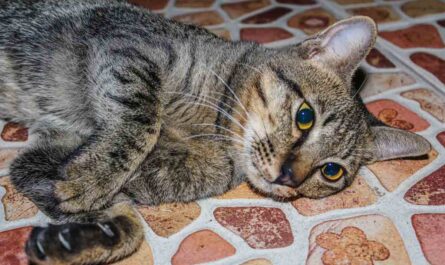Petting a fearful cat can be a delicate task, requiring patience, empathy, and a keen understanding of feline behavior. Cats, by nature, can be skittish and easily frightened, especially in unfamiliar or stressful situations. Approaching a fearful cat with sensitivity and care is crucial to building trust and fostering a positive relationship. By following these dos and don’ts, you can help your feline friend feel more secure and comfortable in your presence.
Petting a Fearful Cat: 10 Dos and 10 Don’ts for Every Owner
Dos:
1. Gentle Approach with a Fearful Cat
Move Slowly and Calmly: When approaching a fearful cat, it’s important to move slowly and avoid sudden movements that may startle them. By approaching with calmness and patience, you can help the cat feel more at ease and reduce their fear response.
Reassuring Communication: Speak softly in a reassuring tone to let the cat know that you mean no harm. Using gentle, soothing words can help to create a sense of safety and trust, encouraging the cat to relax and feel more comfortable in your presence.
2. Allowing the Cat to Take the Lead
Respect Their Boundaries: Allow the cat to initiate contact on their own terms. Avoid forcing interactions or invading their personal space, as this can increase their fear and cause them to retreat further.
Offering a Hand: Extend your hand for the cat to sniff, allowing them to approach and investigate at their own pace. If the cat shows interest, gently offer your hand for them to rub against, providing them with a positive and non-threatening interaction.
Patience and Understanding: Be patient and understanding as you build trust with the fearful cat. Respect their boundaries and allow them to dictate the pace of interactions, gradually earning their trust over time through gentle and consistent efforts.
3. Respecting the Cat’s Space
Providing Adequate Space: It’s crucial to respect the cat’s need for personal space, especially when they are feeling fearful or anxious. Avoid crowding or cornering them, and allow them the freedom to retreat to a safe hiding spot if they feel overwhelmed or threatened.
Creating a Safe Environment: Ensure that the cat has access to quiet, secluded areas where they can seek refuge and feel secure. Provide hiding spots such as cozy beds, boxes, or elevated perches where they can retreat when they need a break from social interactions.
4. Using Gentle Petting Techniques
Soft and Gentle Strokes: When petting a fearful cat, use slow and gentle strokes to avoid overwhelming them. Approach with a calm demeanor and extend your hand slowly, allowing the cat to sniff and investigate before initiating contact. Use light pressure and avoid quick or forceful movements that may startle the cat.
Observing Body Language: Pay close attention to the cat’s body language and vocalizations while petting them. Look for signs of relaxation, such as purring, kneading, or slow blinking, indicating that they are enjoying the interaction. Conversely, be alert for signs of discomfort, such as tense body posture, flattened ears, or twitching tail, and stop petting if the cat shows signs of distress.
Respecting Boundaries: Respect the cat’s boundaries and be responsive to their cues. If the cat shows signs of discomfort or tries to move away, give them space and refrain from further interaction. By respecting the cat’s signals and using gentle petting techniques, you can create a positive and rewarding experience for both you and the cat.
5. Using Treats for Positive Reinforcement
Encouraging Positive Associations: Use treats to create positive associations with your presence and interactions. Offer treats as rewards for calm behavior and positive interactions, reinforcing trust and confidence in your relationship with the cat.
Rewarding Calm Behavior: When the cat displays calm behavior or approaches you willingly, offer treats and praise to reinforce their positive actions. This encourages the cat to associate your presence with pleasant experiences, building trust and strengthening your bond over time.
6. Creating a Safe and Secure Environment
Providing Hiding Spots: Ensure that the cat has access to hiding spots where they can retreat to feel safe and secure. Provide cozy beds, boxes, or other enclosed spaces where the cat can seek refuge when they feel overwhelmed or stressed.
Offering Elevated Perches: Cats feel safest when they can observe their surroundings from an elevated vantage point. Provide elevated perches such as cat trees, shelves, or window ledges where the cats can perch and survey their environment, promoting feelings of security and confidence.
Designating Quiet Areas: Create quiet areas in your home where the cat can relax and unwind without disruptions. Minimize noise and activity in these areas to create a peaceful environment where the cat can feel at ease and comfortable.
7. Exercising Patience and Persistence
Understanding Time Requirements: Building trust with a fearful cat is a gradual process that requires patience and persistence. Recognize that it may take time for the cat to feel comfortable and secure in your presence, and be prepared to invest the necessary time and effort to nurture a positive relationship.
Consistency in Interactions: Consistency is key when working with a fearful cat. Be patient and consistent in your interactions, allowing the cat to progress at their own pace. Avoid rushing or forcing interactions, as this can increase the cat’s anxiety and hinder trust-building efforts.
8. Identifying Triggers and Minimizing Exposure
Observing Fear Responses: Pay close attention to the cat’s behavior and body language to identify triggers that elicit fear responses. Common triggers may include loud noises, sudden movements, or unfamiliar people or animals. By observing the cat’s reactions, you can gain insight into their specific fears and take steps to minimize exposure to these triggers.
Creating a Safe Environment: Once you have identified the cat’s triggers, take proactive measures to create a safe and secure environment that minimizes exposure to these stimuli. For example, if the cat is afraid of loud noises, create a quiet and peaceful environment by reducing noise levels and providing hiding spots where the cat can retreat when feeling overwhelmed.
Gradual Desensitization: Gradual desensitization techniques can also help address fear responses. Introduce the cat to their triggers in a controlled and gradual manner, gradually increasing exposure over time while providing positive reinforcement and rewards for calm behavior. This can help the cat become more comfortable and confident in the presence of previously feared stimuli.
9. Seeking Professional Guidance
Consulting with Experts: If the cat’s fearfulness persists or worsens despite your efforts, it’s important to seek guidance from a veterinarian or animal behaviorist. These professionals have the expertise and experience to assess the cat’s behavior, identify underlying causes of fear, and develop a tailored treatment plan to address their specific needs.
Comprehensive Evaluation: A veterinarian can conduct a thorough physical examination to rule out any medical conditions that may be contributing to the cat’s fearfulness. An animal behaviorist can then assess the cat’s behavior and environment, offering insights into potential triggers and recommending behavior modification techniques to help the cat overcome their fears.
10. Celebrating Progress
Acknowledging Achievements: Celebrate each small victory and milestone in the cat’s progress, no matter how minor. Whether it’s approaching you for a treat, exploring a new environment, or showing curiosity toward unfamiliar objects, each positive interaction strengthens the bond between you and the cat.
Positive Reinforcement: Use positive reinforcement techniques such as treats, praise, and affection to reinforce desired behaviors and encourage further progress. By celebrating small victories, you not only boost the cat’s confidence and self-esteem but also reinforce their trust in you as a caregiver.
Patience and Persistence: Remember that building trust and overcoming fear takes time and patience. Be persistent in your efforts and remain committed to supporting the cat’s emotional well-being. With time, patience, and support, many fearful cats can learn to feel more secure and comfortable in their surroundings.

Don’ts:
1. Ignore Their Body Language
Observing Cues: Pay close attention to the cat’s body language as a means of understanding their emotional state. Look for signs such as flattened ears, dilated pupils, and a tense body posture, which may indicate discomfort or fear. Responding to these signals promptly and appropriately is crucial for maintaining the cat’s trust and comfort.
Interpreting Signals: Flattened ears, dilated pupils, and a tense body posture are all common indicators of stress or anxiety in cats. By recognizing these signals, you can adjust your approach and provide the cat with the space and reassurance they need to feel safe and secure.
2. Introduce Them to New People or Pets Too Quickly
Taking It Slow: When introducing a fearful cat to new people or pets, it’s important to take things slow and proceed at the cat’s pace. Avoid overwhelming them by allowing them to acclimate gradually to unfamiliar individuals or animals.
Supervised Introductions: Supervise introductions closely, providing a controlled environment where the cat feels safe and supported. Keep interactions brief initially, gradually increasing the duration and proximity as the cat becomes more comfortable.
Offering Reassurance: Provide plenty of reassurance and support during introductions, using soothing tones and gentle gestures to help the cat feel at ease. Be patient and understanding, allowing the cat to approach new people or pets on their own terms.
3. Approach from Above
Avoid Looming Presence: To avoid intimidating the cat, refrain from looming over them or approaching from above. Instead, crouch down to their level to appear less threatening and make yourself more approachable.
Crouch Down: By crouching down to the cat’s level, you demonstrate respect for their boundaries and create a less intimidating presence. This allows the cat to feel more comfortable and less vulnerable in your presence.
4. Corner or Trap Them
Never Corner or Trap: It’s essential never to corner or trap a fearful cat, as this can trigger a fight or flight response, leading to aggression or further fear. Always provide the cat with an escape route, ensuring they feel safe and in control of their environment.
Offering Escape Routes: When interacting with a fearful cat, ensure they have access to open spaces and pathways to retreat if they feel overwhelmed. Avoid blocking their exits or restricting their movement, allowing them to navigate their surroundings freely.
5. Stare Directly into Their Eyes
Avoid Direct Staring: Staring directly into a cat’s eyes can be perceived as threatening or confrontational, especially by a fearful cat. Instead, communicate relaxation and trust by blinking slowly, which mimics a friendly gesture in cat language.
Slow Blinking: Slow blinking is a non-threatening way to communicate with cats, signaling that you are calm, friendly, and not a threat. Practice slow blinking towards the cat to help them feel more at ease and build trust over time.
6. Make Loud or Sudden Noises
Minimize Loud Noises: Loud noises or sudden movements can startle a fearful cat and reinforce their fear response, making it challenging to build trust and comfort. Keep the environment calm and quiet, minimizing disturbances that may trigger anxiety or stress in the cat.
Create a Peaceful Atmosphere: Provide a tranquil environment for the cat by reducing noise levels and avoiding sudden disruptions. Limit loud activities or noises in the vicinity of the cat’s space to help them feel secure and relaxed during interactions.
7. Force Contact
Avoid Forceful Contact: Never force physical contact or attempt to pick up a fearful cat. This can cause them to become more anxious and may trigger defensive behavior. Instead, allow the cat to approach you on their terms and respect their boundaries.
Encourage Autonomy: By giving the cat space and autonomy to choose when and how they interact with you, you create a sense of safety and trust. Allow them to initiate contact and gradually build confidence at their own pace. Motivation – Mind – Success – Thinking – Productivity – Happiness
8. Punish Fearful Behavior
Avoid Punishment: Punishing a fearful cat for displaying fear will only reinforce their negative associations and erode trust. Instead, focus on positive reinforcement techniques to encourage desirable behaviors and build a stronger bond with the cat.
Offer Reassurance: When the cat exhibits fearful behavior, respond with patience and reassurance rather than punishment. Use soothing tones and gentle gestures to comfort the cat, helping them feel safe and secure in your presence.
9. Overwhelm Them with Attention
Respecting Boundaries: While it’s essential to interact with a fearful cat to build trust, it’s equally important to respect their boundaries and avoid overwhelming them with too much attention. Pay attention to the cat’s body language and cues, and give them space to decompress and recharge when needed.
Balancing Interaction: Find a balance between providing social interaction and allowing the cat time alone to relax and unwind. Offer gentle interactions, such as softly speaking to the cat or offering treats, but also give them opportunities to retreat to quiet, safe spaces where they can feel secure. Cat accessories on Amazon
10. Give Up Too Easily
Embracing Challenges: Building trust with a fearful cat can be challenging, but it’s a journey worth undertaking. Don’t give up on the cat too easily, even if progress seems slow or setbacks occur along the way. With time, patience, and dedication, fearful cats can learn to feel safe and secure in your presence.
Staying Committed: Remain committed to building a positive relationship with the cat, even when faced with obstacles or setbacks. Remember that trust takes time to develop, and each small step forward is a victory worth celebrating. By persevering with patience and dedication, you can help the cat overcome their fears and build a stronger bond based on trust and mutual respect.
Other Interesting Articles
- Cat Flu: Symptoms, Medicine, Treatment, Text Kit, Prevention
- Cat Herpesvirus 1 (FHV-1): Causes, Symptoms, Treatment
- Do Cats Enjoy Mating? A Guide To Feline Sexual Behavior
- Benefits of a High-Protein Diet for Your Cat: A Complete Guide
- How Many Kittens Can A Cat Give Birth To: When To Worry
- Why is My Cat Drinking Much Water All of A Sudden? To-Dos
- Cat Dystocia (Difficult Birth): Causes, Symptoms, Treatment
- 23 Signs That Indicate Something is Wrong with Your Cat
- Cat Eyes Signs: 15 Things Your Cat Is Saying With Its Eyes
- How Cat Eyes Work: How to Care for Your Feline’s Eyes
- Why Does My Cat Sit On My Shoulder? Reasons, To-Dos
- Why is My Cat So Clingy? Behavior, Reasons, Solutions
- Cat Vomiting: Types, Causes, Symptoms, Treatments, Cure
- Feline Estrous Cycle: What To Expect When A Cat Is in Heat
- Weight Gain in Cats: Obesity Signs, Causes & What to Do
- 13 Ways to Tell if A Cat is Pregnant: Signs, Behavior, Guide
- Cat Pregnancy: Signs, Nipples, Behavior, Care, What To Do
- Nesting Behavior in Cats: Signs, Reasons, What To Do
- How To Help Your Cat Put Their Best Paw Forward: 12 Steps
- How To Improve Your Cat’s Behavior in 14 Systematic Steps



